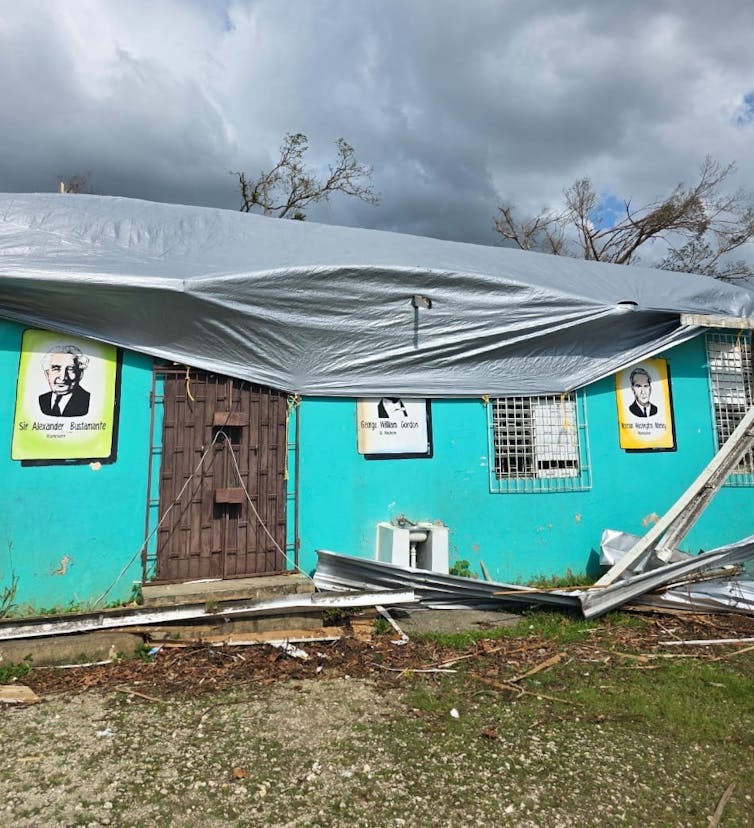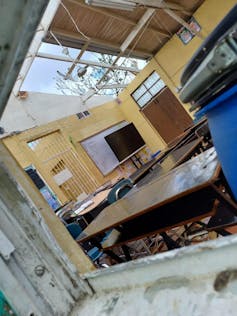- Home
Edition
Africa Australia Brasil Canada Canada (français) España Europe France Global Indonesia New Zealand United Kingdom United States Edition:
Global
Edition:
Global
- Africa
- Australia
- Brasil
- Canada
- Canada (français)
- España
- Europe
- France
- Indonesia
- New Zealand
- United Kingdom
- United States
 Academic rigour, journalistic flair
Academic rigour, journalistic flair
 Parts of the roof of the St. Elizabeth Technical High School are missing in Santa Cruz, Jamaica, Oct. 29, 2025, after Hurricane Melissa passed.
(AP Photo/Matias Delacroix)
Weak infrastructure leaves Jamaican schools devastated in the aftermath of Hurricane Melissa
Published: November 23, 2025 1.43pm GMT
Giselle Thompson, Meshia Brown, University of Alberta
Parts of the roof of the St. Elizabeth Technical High School are missing in Santa Cruz, Jamaica, Oct. 29, 2025, after Hurricane Melissa passed.
(AP Photo/Matias Delacroix)
Weak infrastructure leaves Jamaican schools devastated in the aftermath of Hurricane Melissa
Published: November 23, 2025 1.43pm GMT
Giselle Thompson, Meshia Brown, University of Alberta
Authors
-
 Giselle Thompson
Giselle Thompson
Assistant Professor, Faculty of Education, University of Alberta
-
 Meshia Brown
Meshia Brown
Research assistant, Faculty of Education, University of Alberta
Disclosure statement
Giselle Thompson received funding from the Social Science and Humanities Research Council of Canada (SSHRC) and the Killam Trusts. She is affiliated with the not-for-profit organization, World Class Jamaica.
Meshia Brown does not work for, consult, own shares in or receive funding from any company or organisation that would benefit from this article, and has disclosed no relevant affiliations beyond their academic appointment.
Partners
University of Alberta provides funding as a founding partner of The Conversation CA.
University of Alberta provides funding as a member of The Conversation CA-FR.
View all partners
DOI
https://doi.org/10.64628/AAM.u3v7tcdmc
https://theconversation.com/weak-infrastructure-leaves-jamaican-schools-devastated-in-the-aftermath-of-hurricane-melissa-269783 https://theconversation.com/weak-infrastructure-leaves-jamaican-schools-devastated-in-the-aftermath-of-hurricane-melissa-269783 Link copied Share articleShare article
Copy link Email Bluesky Facebook WhatsApp Messenger LinkedIn X (Twitter)Print article
The devastation in Jamaica caused by Hurricane Melissa exposed a harsh reality that’s been hidden in plain sight for decades — most schools were not structurally sound enough to sustain high winds, heavy rainfall and storm-surge flooding.
Almost 800 government schools were designated as community shelters before Hurricane Melissa descended. More than 600 were damaged when the hurricane hit. Roofs were blown off. Walls collapsed. Windows broke. Debris scattered everywhere.
Citizens found themselves in “shelters” that could not protect them from the elements and for this reason have had to find alternative living arrangements.
As education researchers based in the Jamaican diaspora whose combined work has examined the Jamaican education system, we are deeply concerned about the future of Jamaica’s schools and their ability to not only serve students and teachers — but to be safe havens in natural disasters.
These thoughts came to mind as we watched reels of footage of Hurricane Melissa’s destruction on social media with feelings of helplessness and regret.
Personal exchanges with friends, research collaborators and family members — who are fortunate to have electricity, cellular service or access to WiFi — told us about harrowing experiences on the ground, especially in communities in western and southern parishes such as Hanover, Westmoreland, St. James and St. Elizabeth.
Principals raise red flags
Previous research carried out by Giselle Thompson, the lead author of this story, has examined education spending in Jamaica and how members of the Jamaican diaspora in Canada support schools “back home” through formal and informal fundraising initiatives.
This research was undertaken in partnership with a primary school community, including the principal, teachers, students, families and neighbours in Hanover. They welcomed Giselle to work with them as a supply teacher, recess monitor and in other supportive roles they needed in 2018.
Being immersed in their everyday, under-resourced environment and having one-on-one conversations with them forged lasting personal and professional bonds that form the foundation of current research. It also offered insight into the structural inequities and related vulnerabilities inherent in the Jamaican school system.
 Tarp over a primary school in Ramble, Hanover, on Nov. 11, after Hurricane Melissa.
(Giselle Thompson), Author provided (no reuse)
Tarp over a primary school in Ramble, Hanover, on Nov. 11, after Hurricane Melissa.
(Giselle Thompson), Author provided (no reuse)
At a media briefing before Hurricane Melissa struck, Jamaica’s minister of local government and community development criticized schools that were designated emergency shelters for electing not to open to the public.
But in June 2025, the Jamaica Gleaner reported that some principals raised concerns about the schools, saying they lacked adequate sanitation facilities, weren’t furnished with items that people would need in a shelter or were in need of repair.
These issues were recently echoed in a conversation with a Jamaican principal and research collaborator on Giselle’s current research project, funded by Social Sciences and Humanities Council of Canada and Killam Trusts. The study involves three public primary schools in Hanover and Westmoreland and examines Afro-Jamaican women teachers’ care work in these rural areas.
The principal noted her concerns were ignored when she brought them to the attention of personnel from the Office of Disaster Preparedness and Emergency Management (ODPEM) when her school was assessed and put on the emergency shelter list before the hurricane. Ninety per cent of ODPEM-designated shelters were schools, and close to 78 per cent of them were destroyed.
She also said the expectations of school staff during sheltering periods were unclear, and she was worried about the implications of leaving schools with scant resources unlocked without oversight.
Given the extensive and likely irreparable damages to her school, her decision to keep its doors closed may have been a life-saving move.
An account like this stands in contrast with the Ministry of Education, Skills, Youth and Information’s announcement that it had “taken deliberate and comprehensive steps to ensure the resilience of the education sector” and that the school “facilities are prepared for what is forecast to be an active hurricane season.”
Structural vulnerabilities
Approximately $5.5 million (J$628 million) was spent to prepare 204 schools for hurricane season in the 2025-26 academic year after Hurricane Beryl, a Category 4 storm, damaged 101 institutions in 2024.
 Damage to a roof at a primary school in Ramble, Hanover, on Nov. 11, after Hurricane Melissa.
(Giselle Thompson), Author provided (no reuse)
Damage to a roof at a primary school in Ramble, Hanover, on Nov. 11, after Hurricane Melissa.
(Giselle Thompson), Author provided (no reuse)
This injection of capital was part of a more than $50 million (J$5 billion) government infrastructure preparation project for Hurricane Melissa’s descent.
Although not all schools were damaged in the hurricane, the high percentage of those impacted is a cause for concern. But the structural vulnerability of many Jamaican schools to the effects of climate change is nothing new.
Read more: COP30: Pacific leaders now have world court backing to call countries to account over climate risk
It is directly linked to decades of under-resourcing, particularly in the “era of structural adjustment” (1977 to present) as the state has had to adopt severe austerity measures imposed by the International Monetary Fund and other international financial institutions to reduce its spending on public goods such as education.
Such fiscal belt-tightening is meant to help Jamaica and other heavily indebted countries placate their debt to external creditors. But this economic growth formula is seldom associated with social development.
The cost of inflation and the forced devaluation of the Jamaican dollar — additional austerity measures required by international financial institutions — have reduced government capacity to adequately resource school infrastructure.
Jamaica Teachers’ Association advocacy
Since 1977, the year that structural adjustment programs took root in Jamaica, education spending has fluctuated between five and six per cent of the country’s GDP. However, many stakeholders, including the Jamaica Teachers’ Association (JTA), have been vocal about the negative implications of inadequate spending on education for several years.
In 2024, the JTA president said such low spending puts the nation “woefully” behind. Much needed physical infrastructure and maintenance (and, we might add, books and other learning materials, nutritional programs and transportation) have lagged as a result.
It’s therefore not difficult to comprehend why the scale of Hurricane Melissa’s assault on schools was so significant.
Casting a hopeful vision
Through our ongoing engagements in Jamaica as scholars, educators, activists and community members, we have borne witness to, and are involved in, ongoing efforts to support numerous aged, decrepit and crumbling school structures, which are the result of the state’s neglect and weather systems that are growing increasingly harsh.
We write with hope for the future, one that includes new ecologically resilient schools for teaching and learning and where community members can shelter safely when natural disasters hit. This is essential because Jamaica, and the wider Caribbean region, is susceptible not only to hurricanes, but also floods, landslides, earthquakes and other hazards.
Yet we are not optimistic that the state alone can effect necessary changes because of its heavily indebted status, and therefore, relatively weak capacity.
Read more: 4 urgent lessons for Jamaica from Puerto Rico’s troubled hurricane recovery – and how the Jamaican diaspora could help after Melissa
Although not an explicit admission, the creation of the National Education Trust in 2010 to raise funds and resources for schools, demonstrates this. The state has already begun its official solicitation of support from the international community.
But as members of the Jamaican diaspora in Canada, we urge others in our communities who are interested in supporting the reconstruction of schools in Jamaica to engage with principals, teachers, students and local community members directly so they are able to convey their institutions’ immediate and long-term needs.
This will increase the efficacy of our support and strengthen our ability to work together as Jamaicans at home and abroad.
- Climate change
- Global warming
- Extreme weather
- Flooding
- Hurricanes
- structural adjustment programs
- International Monetary Fund (IMF)
- Hurricane Melissa
Events
Jobs
-
 Lecturer in Paramedicine
Lecturer in Paramedicine
-
 Associate Lecturer, Social Work
Associate Lecturer, Social Work
-
 Lecturer, Communication Design
Lecturer, Communication Design
-
 Leading Research Centre Coordinator
Leading Research Centre Coordinator
-
 Chairperson, Animal Ethics
Chairperson, Animal Ethics
- Editorial Policies
- Community standards
- Republishing guidelines
- Analytics
- Our feeds
- Get newsletter
- Who we are
- Our charter
- Our team
- Partners and funders
- Resource for media
- Contact us
-
-
-
-
Copyright © 2010–2025, The Conversation

 Lecturer in Paramedicine
Lecturer in Paramedicine
 Associate Lecturer, Social Work
Associate Lecturer, Social Work
 Lecturer, Communication Design
Lecturer, Communication Design
 Leading Research Centre Coordinator
Leading Research Centre Coordinator
 Chairperson, Animal Ethics
Chairperson, Animal Ethics



